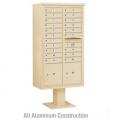Pedestal Mailbox Progression Persists
 Pedestal mailboxes have evolved over the past twenty five years from the Neighborhood Delivery and Collection Unit (NDCBU) to the different generations of cluster box units, and ending with today’s 4C pedestal mailbox. Each pedestal mailbox progression has been an improvement of some sort in most industry professional’s eyes.
Pedestal mailboxes have evolved over the past twenty five years from the Neighborhood Delivery and Collection Unit (NDCBU) to the different generations of cluster box units, and ending with today’s 4C pedestal mailbox. Each pedestal mailbox progression has been an improvement of some sort in most industry professional’s eyes.
The Neighborhood Delivery and Collection Box was the postal certified pedestal mailbox until the late nineteen nineties. The NDCBU pedestal mailbox was rear loading for the U.S. Postal Service mail carrier and the tenants retrieved their mail from the front of the unit. The standard resident size door for the NDCBU was approximately 5 inches by 6 inches by 15 inches deep. Commercial mailbox manufacturers offered the NDCBU pedestal mailbox in three stock sizes which were an 8, 12, and 16 tenant door units. The USPS allowed modifications of the NDCBU which usually resulted in larger resident doors, an outgoing compartment or a parcel locker or two. The primary reasons for the USPS movement from the NDCBU to the cluster box unit (CBU) was mail security, larger tenant doors as the standard, built in parcel lockers and changing the load of the CBU for the mail carrier to front load.
The cluster box unit was the Postal Service’s answer to improve the delivery of the mail for their mail carriers, improve mail security and adjust the size of resident doors to better reflect the size of today’s mail. In addition, the cluster box design features one or two parcel lockers per pedestal mailbox for secure package delivery. The E Series cluster box was the first generation CBU released to the marketplace in the late nineteen nineties. The E Series cluster box units was made available by centralized mailbox manufacturers in eight, twelve, thirteen, and sixteen resident door units. The F Series cluster box preceded the E Series CBU because the Postal Service wanted to further enhance the security features of the cluster box unit. The one major drawback the marketplace has voiced about the cluster box unit was the lack of configuration flexibility. The Postal Service prohibited modifications of cluster box, which lead to the creation of the 4C pedestal mailbox.
The 4C pedestal mailbox is the latest creation by the commercial mailbox manufacturers. The 4C pedestal mailbox is an extension of the 4C horizontal mailboxes released in 2006 as the USPS Approved wall installation mailbox. The 4C pedestal mailbox is offered by multiple manufacturers in hundreds of pre-configured front loading models. In addition, the 4C pedestal mailbox can be modified within the mailbox frame and the commercial mailbox manufacturer’s door size offerings. The major drawback of the 4C pedestal mailbox is it has not yet gained the national USPS endorsement. Therefore, local postmaster is required to use a 4C pedestal mailbox for U.S. Mail delivery.
The pedestal mailbox evolution has happened rapidly over the past decade after many years of use of the industry staple Neighborhood Delivery and Collection Box Unit. The progression to today’s 4C pedestal mailbox has been logical and it should be interesting to see the next generation of pedestal mailboxes.

 Submit Project Specs & Plans Here
Submit Project Specs & Plans Here